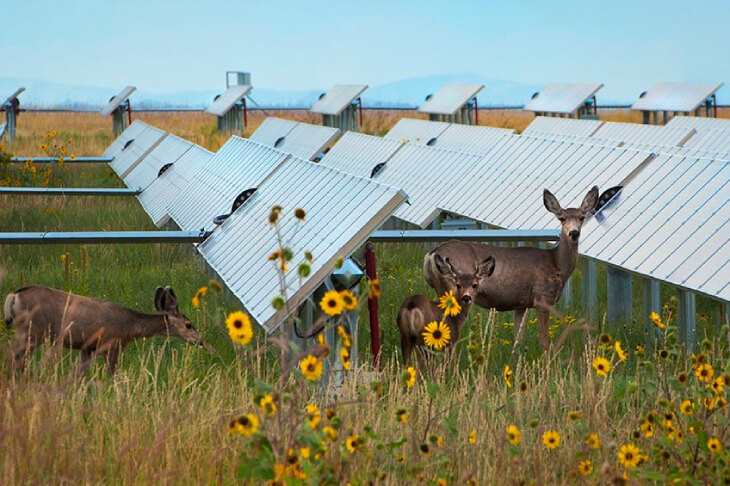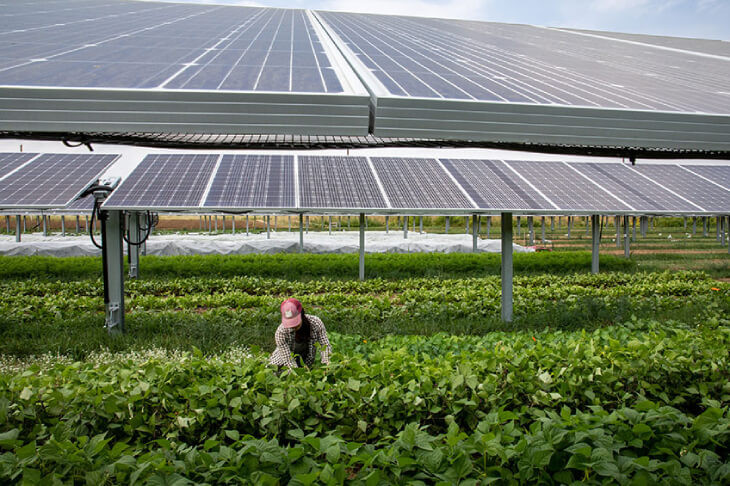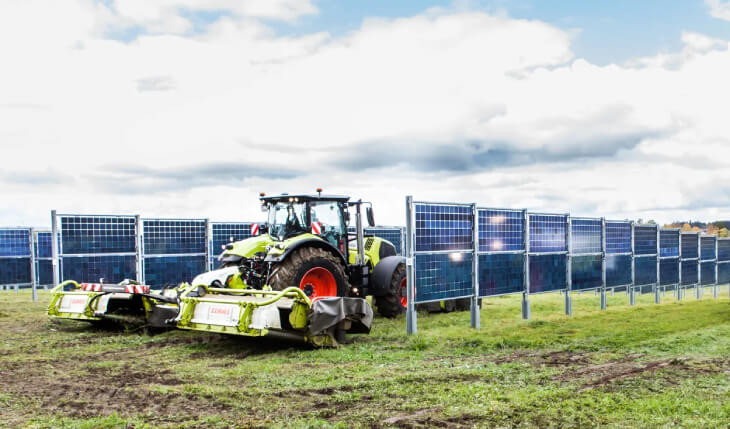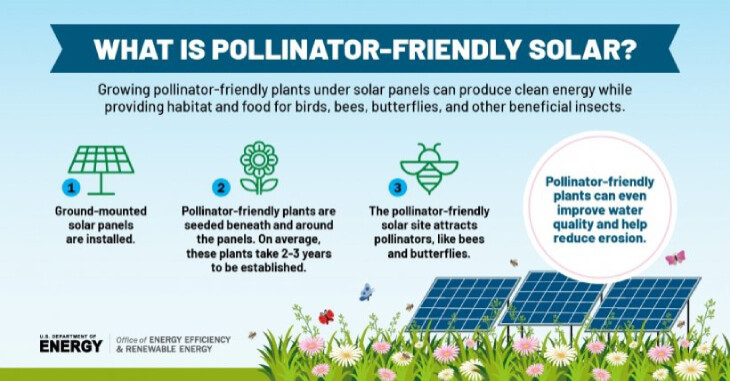Agrivoltaics: Dual Benefits for Farming and Renewable Energy
Insights | 02-05-2024 | By Gary Elinoff

Deer graze under a National Renewable Energy Laboratory (NREL) photovoltaic (PV) array. Incorporating native vegetation under and around solar panels can create a habitat for local wildlife and insects while also improving soil conditions. Image source: NREL
Key Takeaways about Agrivoltaics:
- Solar installations designed for agrivoltaics can also boost local biodiversity by providing habitats for various species, contributing to ecosystem stability and resilience.
- Solar generation can be quite complementary to agriculture
- Agrivoltaics will serve to lessen local opposition to solar power generation
- In order for renewable energy to reach its full potential, an enhanced nationwide power grid must be established
Introduction
Solar installations, unlike hydrocarbon-based power generating plants or nukes, sit lightly on the land. And, unlike the imposing, beautiful, but now outdated Ivanpah solar plant of the last decade, there is no 450-foot tower and the massive construction needed to support it. Today’s plants look like nothing so much as a section of chain link fence. They are easily installed and moved.
The environmental benefits of agrivoltaics extend beyond just energy production. Incorporating natural vegetation under and around solar panels helps improve soil conditions and biodiversity, supporting local wildlife without the need for extensive land modification.
Most land that is set aside for the purpose of harvesting solar power is devoted solely to that purpose - but it doesn’t have to be. As it turns out, it is entirely possible, and indeed desirable, to gather solar energy and conduct practical agricultural enterprises on the same land. It’s called agrivoltaics, and as reported in an article published by the US Office of Energy Efficiency & Renewable Energy, Solar Energy Technologies Office (SETO)[1], as of March 2023, the National Renewable Energy Laboratory had identified 314 agrivoltaic projects, collectively generating a whopping 2.8 GW of solar capacity, the equivalent of three nuclear power plants.
Agrivoltaics, also known as co-location or dual-use solar, happens when crop production or livestock production takes place underneath or adjacent to the actual energy-gathering solar panels themselves.
Agrivoltaics helps to Reduce Opposition to Solar Power
As described in a video by the NREL[2], solar plants are often built on agricultural lands, which can lead to opposition from the local communities, who are often philosophically and almost religiously opposed to prime agricultural lands getting taken out of production. Agrivoltaics offers the opportunity to continue agricultural production while at the same time allow the generation of clean, carbon free electrical energy.
Local communities often see direct benefits from agrivoltaic installations, including job creation and sustained agricultural productivity, which can help reduce opposition to new solar developments.
Agrivoltaics Can Improve Crop Production
The presence of solar panels can reduce the amount of direct sunlight that impacts a food plant as it grows by creating a “microclimate” that is warmer at night and cooler by day. As noted in another NREL article[3], the solar panels can also increase the moisture content of soil that is adjacent to or under the physical solar panels, which can be a benefit to crop yields and quality. In arid lands, this may decrease the amount of irrigation or watering required, and in wet climates, the spacing of the panels can play a role in managing water distribution.
This microclimate effect can reduce thermal stress on plants during critical growth periods, potentially increasing the resilience of crops to climatic anomalies, which is increasingly vital in the face of global climate change.

Agricultural Production and solar power can both thrive under agrivoltaics. Image source: NREL
The presence of livestock can also be a boon to the economics of solar power by simply grazing under the panels, eating away the plants that impact the structures, thereby reducing the need for herbicides. The animals themselves stand to benefit from the shade the panels provide, shielding them from the sun on especially hot days.
Vertically Mounted Solar Panels for Agrivoltaics
German startup Next2Sun seeks to minimize the amount of land solar cells taken up through the use of bifacial solar modules that are installed vertically and efficiently collect sunlight from both the front and back side of their panels.

Vertically mounted solar panel from Next2Sun are well suited for the Agricoltaic Growing of Potatoes and Hay. Image source: IEEE Spectrum
The use of vertically mounted panels not only maximizes the efficiency of land use but also allows for easier access and maintenance of the land for agricultural activities, ensuring that farming operations can continue seamlessly alongside energy production.
In an article published in the IEEE Spectrum[4], Next2Sun’s Heiko Hildebrandt explains how Germany’s high population density naturally limits the amount of land available for solar power generation. The obvious solution is to use each precious acre as efficiently as possible, and using the same field for farming and PV generation is a smart move. The company is partnering with iSun, a Vermont-based firm, on a four-acre project in that state that will produce carrots, beetroot and saffron crops.
There is still work to be done. As explained by Steven Loheide, a water resources engineering professor at the University of Wisconsin Madison who has studied agrivoltaics, “We need to better understand how hydrologic and ecological processes respond to the novel shading and water redistribution regimes that exist beneath and around photovoltaic arrays, in order to leverage synergistic opportunities through generation of co-benefits while preventing unintended—but not necessarily unpredictable—consequences,”
Agrivoltaics Facilitates Plant Fertilization
As reported in an article published by the US Solar Energy Technologies Office (SETO)[5], plant pollination by insects, such as bees and butterflies, is critical to the success of about 35 per cent of global food crop production. In order to thrive, these vital insectivorous pollinators must themselves inhabit a suitable environment.

Pollinator Friendly Solar Power. Image source: US Solar Energy Technologies Office
Research now being conducted includes inquiry into how successful agrivoltaic methods have been in attracting bees, that most critical of insectivorous pollinators, to sites established beneath solar panels. And, a SETO funded project led by the University of Illinois is investigating the resulting efficacy of combining agriculture with pollination planting, with analytic tools available for users.
Enhancing pollinator habitats can lead to improved pollination services for nearby agricultural crops, which is essential for maintaining food production levels and agricultural biodiversity.
Any discussion of Renewable Energy must keep Three Considerations in mind
- The sun doesn’t always shine, and the wind doesn’t always blow.
- The lands where renewable energy can be most economically garnered may be nowhere near where it’s needed.
- As of April 2024, despite vast amounts of money being spent on research worldwide, there is no practical way to store solar energy for the long term or even the medium term.
For the first two reasons, energy planners, if such individuals exist, must plan for a nationwide grid of power lines. With such a grid established, electricity can be moved, at any point in time, from where it’s generated to where it’s needed. If the wind isn’t blowing in Kansas, the sun may be baking Nevada!
Even with the adaptation of agrivoltaics and a national grid for sharing local surpluses, there will be times when there is simply not enough renewable energy available anywhere. “Carbon neutrality” is simply not possible at this time. The public has to realize that the enemy of good is perfect, and in this case, the “good” involves what is known as natural gas peaker plants, which can quickly turn on and off. That is a topic for another blog.
With enough solar power generating agrivoltaics and a national power grid, resorting to hydrocarbons can be kept to a minimum. It won’t be perfect, but it’ll be good.
Challenges and Opportunities
Solar energy is seen as a threat by many traditional, rural people who regard agricultural land with an almost religious veneration and recoil at the notion of cropland being used for anything other than growing food. It is hoped that agrivoltaics, which makes it possible to use the same land for both purposes simultaneously, will ameliorate that resistance.
If agrivoltaic endeavors are well thought out, the agricultural results can themselves be improved. And, the extra money the landowner will enjoy from selling the electricity generated will only sweeten the pot.
Wrapping Up
Agrivoltaics is a rapidly developing methodology that is intended to get more out of available land by combining PV solar power generation. Due to improved solar cell efficiency and reduced costs, it is now feasible to co-locate solar power generation with a wide variety of agricultural enterprises.
The microclimates that take hold beneath the solar panels can be beneficial to plant growth. Reliance on watering and irrigation can be reduced, and the areas adjacent to panels can serve to attract agriculturally beneficial insects. With the presence of grazing animals to eat shrubs that might block the path of sunlight to the panels, the need for costly maintenance can be reduced for well-designed agrivoltaic installations.
References:
- Agrivoltaics: Solar and Agriculture Co-Location: https://www.energy.gov/eere/solar/agrivoltaics-solar-and-agriculture-co-location
- NREL’s Agrivoltaics Research: Combining Solar Energy With Agriculture: https://youtu.be/8wo2gAePRqU
- Agrivoltaics: https://www.nrel.gov/solar/market-research-analysis/agrivoltaics.html
- Vertical Panels Let Solar and Farming Coexist - German startup Next2Sun is moving agrivoltaics to the United States: https://spectrum.ieee.org/agrivoltaics
- Buzzing Around Solar: Pollinator Habitat Under Solar Arrays: https://www.energy.gov/eere/solar/articles/buzzing-around-solar-pollinator-habitat-under-solar-arrays
Glossary of Key Terms:
- PV. Photovoltaic. Generally, it refers to the photocell that captures the sun’s rays and converts them into electricity.
- Peaker Plant. Power plants, generally running on natural gas, which can be quickly turned on when the available renewable energy isn’t enough to supply energy needs.
- SETO. The US Solar Energy Technologies Office

